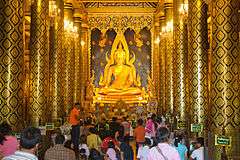Phitsanulok Province
| Phitsanulok พิษณุโลก | ||
|---|---|---|
| Province | ||
| ||
 Map of Thailand highlighting Phitsanulok Province | ||
| Country |
| |
| Capital | Phitsanulok | |
| Government | ||
| • Governor | Supphachai Iamsuwan (since October 2016) | |
| Area | ||
| • Total | 10,815 km2 (4,176 sq mi) | |
| Population (2011) | ||
| • Total | 851,357 | |
| • Density | 79/km2 (200/sq mi) | |
| Human Development Index | ||
| • HDI (2010) | 0.739 (high) (rank?) | |
| Postal code | 65xxx | |
| Calling code | 055 | |
| Vehicle registration | พิษณุโลก | |
| Founded | 11th century | |
| Website | http://www.phitsanulok.go.th | |
Phitsanulok, one of Thailand's seventy-six provinces, lies in lower northern Thailand, borders Sukhothai and Uttaradit on the north, Loei and Phetchabun in the east, and Phichit and Kamphaeng Phet to the south. In the northeast borders Laos.
The name means "Vishnu's heaven". The first element Phitsanu (Thai: พิษณุ) is a cognate of "Vishnu", a Hindu god. The second element lok (Thai: โลก) means "globe" or "world".
The capital is Phitsanulok.
History
| Phitsanulok History This box contains links to selected |
| Prehistoric Era |
|---|
| Khmer Empire |
| Singhanavati City-State |
| Sukhothai Period |
|
Wat Chula Manee · Wat Aranyik |
| Ayutthaya Period |
|
Borommatrailokkanat |
| Modern Siam / Thailand |
The lands situated in the present-day Phitsanulok Province were inhabited since the stone age, although the neolithic inhabitants of the region are not likely to have been the ancestors of the modern Thai people who reside there today. The earliest historical records relating to what is now Phitsanulok Province indicates that at a time prior to or during the 11th century, the present-day city of Phitsanulok was but a small strategic Khmer outpost known as Song Khwae. During the next century, in 1188, Nakhon Thai, located near the center of the present Phitsanulok Province, was established as the capital city of the Singhanavati Kingdom, an early city-state of Thailand. Later, during Thailand's Sukhothai Period, the city of Phitsanulok emerged as a major city in the east of the Sukhothai Kingdom, and the great temples of Wat Chula Manee, Wat Aranyik and Wat Chedi Yod Thong were constructed. In 1357, the renowned Wat Phra Sri Rattana Mahathat was erected, and the Ayutthaya Period witnessed the construction of several of the province's other chief temples. Phitsanulok served for 25 years as the capital city of the Ayutthaya Kingdom. In 1555, King Naresuan the Great was born in the city of Phitsanulok. Naresuan played a significant role in the history of Thailand, as he expanded the kingdom (then called Siam) to its greatest territorial extent, by conquering sizable portions of modern-day Burma and Cambodia. In recent times, Phitsanulok Province has become an important agricultural center, part of the Bread Basket of Thailand, providing rice and other crops to consumers in Thailand and throughout the world. Extensive agricultural development over the last hundred years or so has spawned a modern infrastructure in the urban areas of the province, bringing with it an array of modern roads, universities, hospitals and other conveniences. Over the years, the Nan River and its tributaries have played a substantial role in the history and development of the region by providing a route for transportation, fertile soil for agriculture, and water for irrigation. The river waters have also served as a route for enemy invaders, and have been the source of periodic widespread flooding throughout the province.[1] See also Thai–Laotian Border War (December 1987 – February 1988.)
Symbols
The provincial seal depicts: Phra Buddha Chinnarat, considered one of the most beautiful Buddha figures in Thailand.
The provincial flag is: purple with the provincial seal in the middle of the flag.
The provincial tree is: tree jasmine in Thai dok phip ดอกปีบ or kasalong กาสะลอง.
The provincial flower is: yellow flame tree, in Thai dok nonthri ดอกนนทรี.
The provincial animal is: Thai Bangkaew Dog, in Thai sunakh bangkaew สุนัขบางแก้ว.
The provincial mascot is: yellow white tail fighting cock in Thai kai lueng hang khao ไก่เหลืองหางขาว.
The provincial motto is: "Phitsanulok, a town of the excellent Phra Buddha Chinnarat, the birthplace of King Naresuan the Great, a raft community, with delicious dried bananas as well as fantastic caves and waterfalls".

Religion

As of 2010 the population of Phitsanulok was 95% Buddhist.
Economy
The economy of Phitsanulok Province is driven by agriculture, commercial fishery, mineral resources, industry and tourism. Rice production is the central component of the agricultural sector. The province's rich black soil, intricate canal systems and abundant rainfall provide an ideal environment for growing rice.
Administrative divisions

The province is subdivided in 9 districts (amphoe). These are further subdivided into 93 subdistricts (tambon) and 1032 villages (muban).
- Mueang Phitsanulok
- Nakhon Thai
- Chat Trakan
- Bang Rakam
- Bang Krathum
- Phrom Phiram
- Wat Bot
- Wang Thong
- Noen Maprang
National parks
- Thung Salaeng Luang National Park
- Namtok Chat Trakan National Park
- Kaeng Chet Khwae National Park
- Phu Hin Rong Kla National Park
See also
| Thai Wikisource has original text related to this article: |
References
- ↑ See main article History of Phitsanulok Province for references

